Cairo, the heart of Egypt, is a city where millennia of history coexist with vibrant modern life. From towering pyramids to bustling bazaars, every corner tells a story. If you’re planning your trip in 2025, here is a comprehensive guide to the must-see attractions, enriched with practical tips, cultural insights, and visitor advice.
🏜️ Giza Plateau: The Eternal Icons
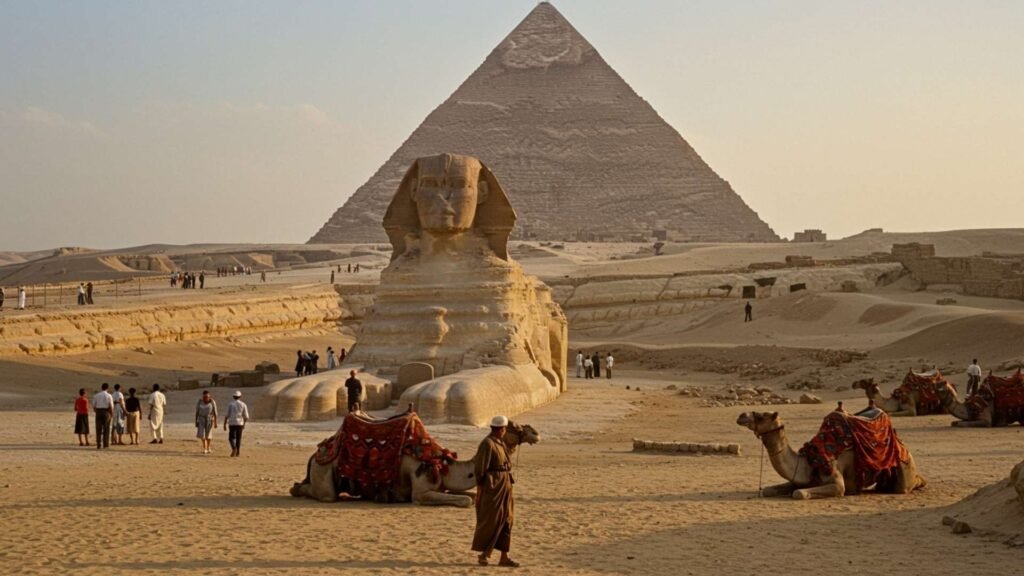
No image represents Egypt more powerfully than the Pyramids of Giza. Standing for over 4,500 years, these monuments continue to captivate travelers from around the world.
🏜️ The Great Pyramid of Khufu (Cheops)
- History & Construction: Built between 2580–2560 BC during Egypt’s Old Kingdom, for Pharaoh Khufu.
- Scale: Originally 146.6 meters tall, now 138.8 meters due to erosion. Constructed with about 2.3 million limestone blocks, each weighing between 2–15 tons.
- Architectural Features: Visitors can enter with a special ticket, exploring the Grand Gallery, the Queen’s Chamber, and the King’s Chamber.
- Significance: The only surviving wonder of the Seven Wonders of the Ancient World.
🏜️ Pyramid of Khafre (Chephren)
- History & Construction: Commissioned by Pharaoh Khafre, Khufu’s son, around 2558–2532 BC.
- Scale: Standing 136.4 meters high, it appears almost equal to the Great Pyramid because it was built on higher ground.
- Distinctive Feature: Still preserves a portion of its original limestone casing at the top, offering a glimpse of how the pyramids once gleamed.
- Complex: Associated with the Great Sphinx, believed to have been constructed as part of Khafre’s mortuary complex.
🏜️ Pyramid of Menkaure (Mykerinos)
- History & Construction: Built during Pharaoh Menkaure’s reign (c. 2490–2472 BC).
- Scale: At 65 meters high, it is the smallest of the three pyramids.
- Architectural Details: Lower sections were clad in granite, while upper portions were made of limestone.
- Artifacts: Famous statues of Menkaure and his queens were discovered here, now housed in the Egyptian Museum.
- Satellite Pyramids: Three smaller pyramids nearby were likely built for queens or royal family members.
🦁 The Great Sphinx of Giza
- History & Construction: Likely built during Khafre’s reign (around 2500 BC).
- Dimensions: 73 meters long and 20 meters high, carved from a single limestone outcrop.
- Symbolism: With a lion’s body and a human head, it represents strength, wisdom, and royal authority.
- Mystery: Scholars debate whose face the Sphinx depicts—most believe it is Khafre. Its nose and beard are missing, with conflicting stories about how they were lost.
- Modern Role: Seen as the eternal guardian of the Giza Plateau, it remains one of the most iconic symbols of Egypt.
✨ In summary:
- Khufu → The greatest engineering feat of the ancient world.
- Khafre → Visually striking, with the Sphinx completing its grandeur.
- Menkaure → Smaller but rich in artistry and detail.
- The Sphinx → A mysterious guardian, shrouded in legend.
💡 Visitor Tips:
- Go early morning (8:00–10:00) or late afternoon (after 3:30) to avoid heat and crowds.
- Ticket prices vary: a general entry covers the site, but entering pyramid chambers requires extra fees.
- Consider hiring a licensed guide to understand the deep history beyond the photo opportunities.
🎟️ Getting There: About 30 minutes from central Cairo. Taxi or Uber is recommended; public buses are available but less comfortable.
🏛️ The Grand Egyptian Museum (GEM)
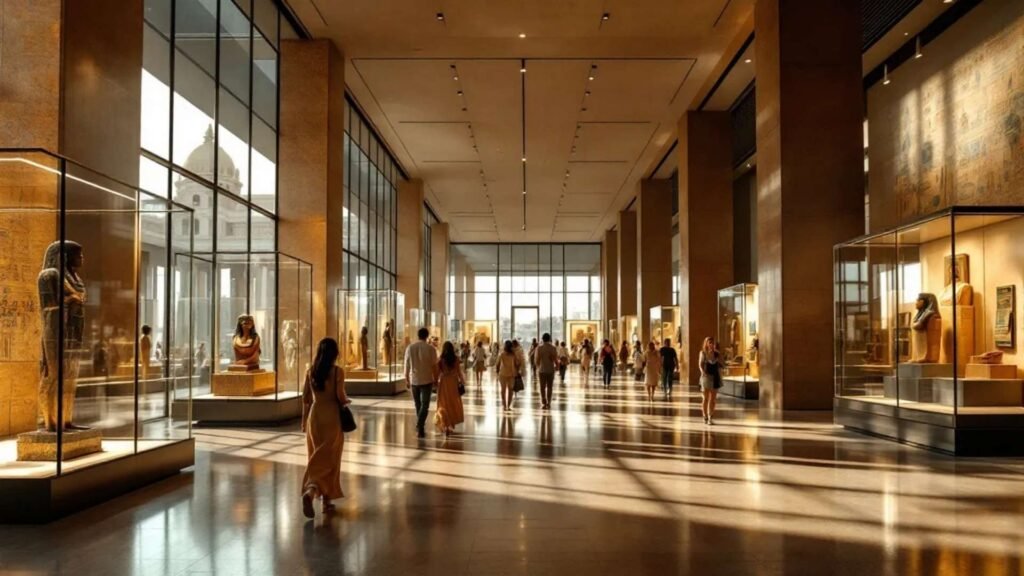
For decades, Egyptologists, travelers, and history lovers have awaited the opening of the Grand Egyptian Museum (GEM). Located just two kilometers from the Giza Pyramids, GEM is set to become the world’s largest archaeological museum. With its long-anticipated full opening scheduled in 2025, it promises to transform Egypt’s tourism scene, offering visitors a once-in-a-lifetime experience of ancient civilization.
✨ Why the Grand Egyptian Museum Matters
The GEM is not just another museum—it represents a new era in cultural preservation and tourism:
- World’s Largest Archaeological Collection: Housing over 100,000 artifacts from Egypt’s pharaonic past.
- Tutankhamun’s Treasures: For the first time, the complete collection of the boy king’s burial treasures—more than 5,000 objects—will be displayed together.
- Cutting-Edge Technology: Modern exhibition design, immersive digital displays, and interactive learning zones bring history to life.
- Strategic Location: With the Pyramids of Giza as its backdrop, GEM offers a seamless blend of Egypt’s ancient and modern wonders.
🏺 Highlights of the Collection
- Tutankhamun’s Treasures: Including the iconic golden death mask, chariots, jewelry, furniture, and personal items. Visitors will see the full scope of the young pharaoh’s life and burial.
- Royal Mummies: Relocated from the Egyptian Museum in Tahrir, these mummies connect visitors directly to Egypt’s legendary rulers.
- Colossal Statues: The museum’s entrance hall features a giant 11-meter statue of Ramses II, setting the tone for the grandeur inside.
- Prehistoric & Greco-Roman Collections: Artifacts spanning Egypt’s long timeline, beyond the pharaonic era.
🏛️ Architecture & Design
The GEM is itself a masterpiece of modern architecture:
- Glass Facade: Designed to frame stunning views of the Giza Pyramids.
- Vast Exhibition Space: Covering nearly 480,000 square meters, with massive halls that allow for large-scale displays.
- Visitor Experience: Includes gardens, cultural event spaces, a children’s museum, restaurants, and shopping areas.
🎟️ Visitor Information (2025)
- Location: On the Giza Plateau, about 2 km from the pyramids. Easily reachable by taxi, Uber, or hotel shuttle.
- Opening Date: Expected full opening in 2025 (partial exhibitions have been previewed since 2018).
- Tickets: Pricing to be confirmed, but advance online booking is highly recommended due to expected high demand.
- Opening Hours: Likely 9:00 am – 5:00 pm, with extended evening hours on certain days.
- Accessibility: Designed with modern facilities, including wheelchair access, elevators, and multi-language guides.
💡 Travel Tips
- Plan at least half a day (4–5 hours) to explore the highlights.
- Combine your museum visit with a trip to the Pyramids of Giza for a full-day cultural experience.
- Arrive early to avoid peak crowds, especially during high tourist season (October–April).
- Don’t miss the interactive digital galleries, which are perfect for children and families.
🕌 Islamic Cairo: Mosques, Citadels, and Medieval Streets
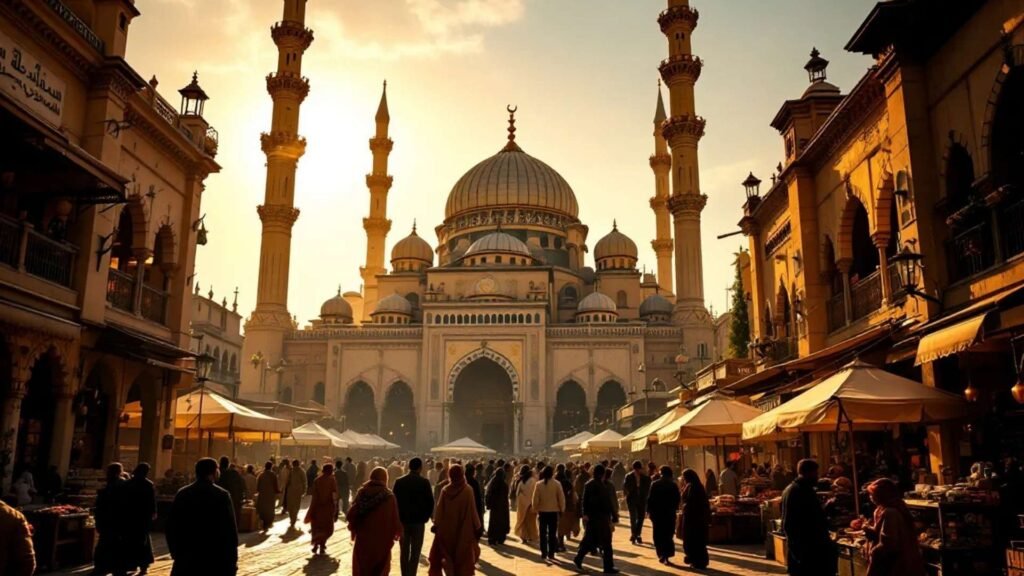
Islamic Cairo is not just a district—it is an open-air museum where centuries of Islamic art, culture, and daily life converge. Recognized as a UNESCO World Heritage Site, this area showcases Egypt’s Islamic heritage through its majestic mosques, fortresses, markets, and winding medieval alleys. For international visitors, exploring Islamic Cairo offers an authentic glimpse into a city where history still lives and breathes in every corner.
1. The Spiritual Heart – Mosques of Islamic Cairo
Islamic Cairo is dotted with mosques that reflect different dynasties and architectural styles. These are not just places of worship, but also cultural landmarks.
- Mosque of Ibn Tulun (9th century): One of the oldest surviving mosques in Cairo, famous for its vast courtyard and unique spiral minaret, inspired by Iraq’s Samarra mosque.
- Al-Azhar Mosque (970 AD): A cornerstone of Islamic scholarship, Al-Azhar is still home to one of the world’s oldest universities. Its gleaming white domes and minarets symbolize Cairo’s role as a beacon of learning.
- Sultan Hassan Mosque (14th century): A masterpiece of Mamluk architecture, this mosque impresses with its soaring walls, monumental entrance, and tranquil courtyard.
- Al-Hakim Mosque: Restored in recent decades, it embodies Fatimid grandeur and is often illuminated beautifully at night.
These mosques invite visitors not only to admire architecture but also to feel the spiritual essence of Islamic Cairo.
2. The Citadel of Saladin – Cairo’s Guardian Fortress
Dominating the skyline, the Citadel of Saladin was built in the 12th century as a defense against Crusader attacks. Today, it stands as one of Cairo’s top landmarks.
- Mosque of Muhammad Ali: Also known as the Alabaster Mosque, this Ottoman-style structure resembles Istanbul’s Blue Mosque and is the citadel’s crown jewel. Its interior glows with chandeliers and calligraphy.
- Military Museum and panoramic views: From the fortress walls, visitors enjoy sweeping views of Cairo stretching to the Pyramids on clear days. The Citadel also houses museums displaying Islamic weaponry, artifacts, and historic documents.
3. Medieval Streets and Bazaars
Walking through Islamic Cairo is like stepping into a living medieval city.
- Al-Muizz Street: The heart of Islamic Cairo, lined with restored mosques, madrasas, and caravanserais. At night, the street glows under lanterns, creating a magical atmosphere.
- Khan el-Khalili Bazaar: Cairo’s most famous market, buzzing with artisans, spice vendors, jewelry shops, and traditional cafés like El-Fishawy, which has served guests for over 200 years.
- Historic Houses: Places like Bayt al-Suhaymi showcase Ottoman-era domestic life, with wooden mashrabiya balconies and peaceful courtyards.
These streets are not just historical—they remain vibrant with daily trade, music, and food, blending past and present seamlessly.
4. Practical Tips for Visitors
- Best Time to Visit: October–April offers cooler, more comfortable weather for exploring on foot.
- Dress Code: Modest clothing is recommended, especially when entering mosques.
- Guided Tours: Hiring a local guide helps uncover hidden details and legends behind monuments.
- Accessibility: The area is best explored on foot, so wear comfortable shoes.
✝️ Historic Churches and the Hanging Church
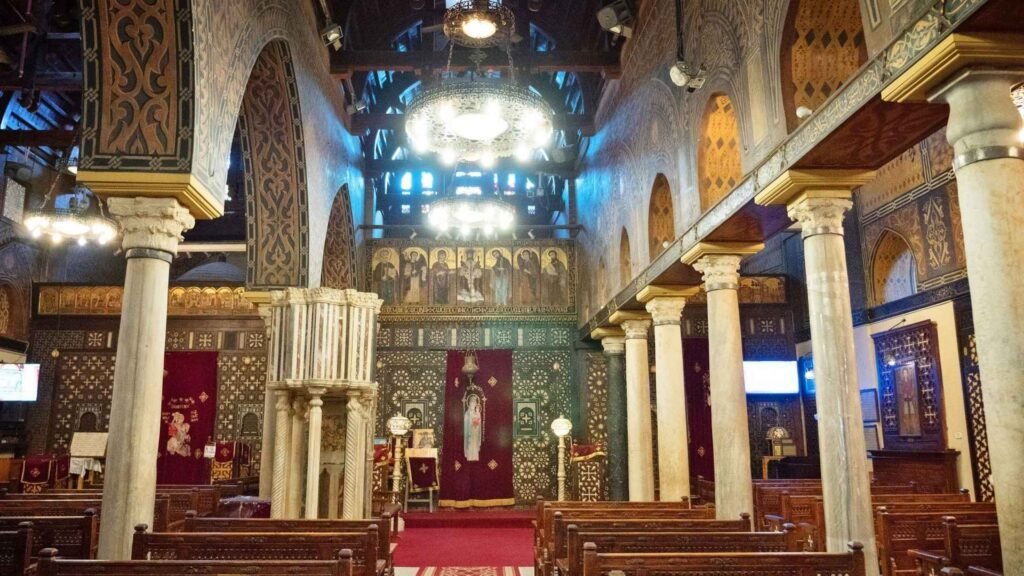
Coptic Cairo is one of the most sacred and historically rich districts in the Egyptian capital. Nestled within the walls of the old Roman fortress of Babylon, this area preserves the legacy of Egypt’s Christian heritage. From the iconic Hanging Church to ancient chapels and synagogues, Coptic Cairo offers a spiritual and cultural journey through the earliest centuries of Christianity in Egypt.
1. The Hanging Church (Saint Virgin Mary’s Coptic Orthodox Church)
The Hanging Church, known locally as Al-Muallaqa, is the crown jewel of Coptic Cairo. Built in the 3rd century above a Roman gatehouse, it earned its name because it seems to “hang” over the fortress’s passageway.
- Architecture & Interior: The church features wooden ceilings shaped like Noah’s Ark, intricate icons of the Virgin Mary and saints, and marble columns of varying styles, symbolizing the diversity of the early Christian community.
- Religious Importance: The Hanging Church served as the seat of the Coptic Orthodox Patriarch for centuries, making it a center of Christian leadership in Egypt.
- Visitor Experience: Today, it remains an active place of worship, where visitors can witness centuries-old traditions in a serene and spiritual setting.
2. Other Historic Churches of Coptic Cairo
Beyond the Hanging Church, Coptic Cairo is home to several remarkable churches, each with its own story.
- Church of Saints Sergius and Bacchus (Abu Serga): Believed to be built on the spot where the Holy Family rested during their flight into Egypt, this church holds immense religious significance for pilgrims.
- Church of Saint Barbara: Known for its collection of relics and icons, it highlights Egypt’s connection to early Christian martyrs.
- Church of the Virgin (Qasr el-Sham’a): Famous for its unique design and historical manuscripts.
These churches represent Egypt’s role in preserving Christianity during its formative years.
3. The Coptic Museum – Preserving Egypt’s Christian Heritage
For those seeking deeper understanding, the Coptic Museum offers one of the most comprehensive collections of Coptic art and artifacts in the world.
- Highlights: Colorful manuscripts, textiles, stone carvings, and icons dating back over 1,600 years.
- Purpose: The museum bridges ancient Egyptian, Greek, Roman, and Islamic influences, showing how Christianity adapted and flourished in Egypt.
4. Synagogues and Interfaith Heritage
Coptic Cairo is also home to the Ben Ezra Synagogue, one of the oldest in Egypt. According to tradition, this is where baby Moses was found in the reeds of the Nile. Its presence highlights the district’s role as a melting pot of faiths and cultures.
5. Exploring the Streets of Coptic Cairo
Walking through Coptic Cairo is a journey into a quieter, more contemplative part of the city. Narrow cobblestone streets, ancient walls, and peaceful courtyards make it a stark contrast to Cairo’s bustling modern neighborhoods.
- Local Life: Pilgrims, monks, and families visit daily, blending spiritual devotion with everyday rhythms.
- Atmosphere: Lanterns, incense, and chanting create an aura of timeless spirituality.
💡 Practical Tips for Visitors
- Best Time to Visit: October–April offers pleasant weather for walking.
- Dress Code: Modest attire is essential when entering religious sites.
- Guided Tours: Local guides bring history to life with stories and hidden details.
- Transport: Coptic Cairo is easily accessible by Cairo Metro (Mar Girgis station).
🏰 The Citadel of Saladin: Stunning Fortress with Panoramic City Views
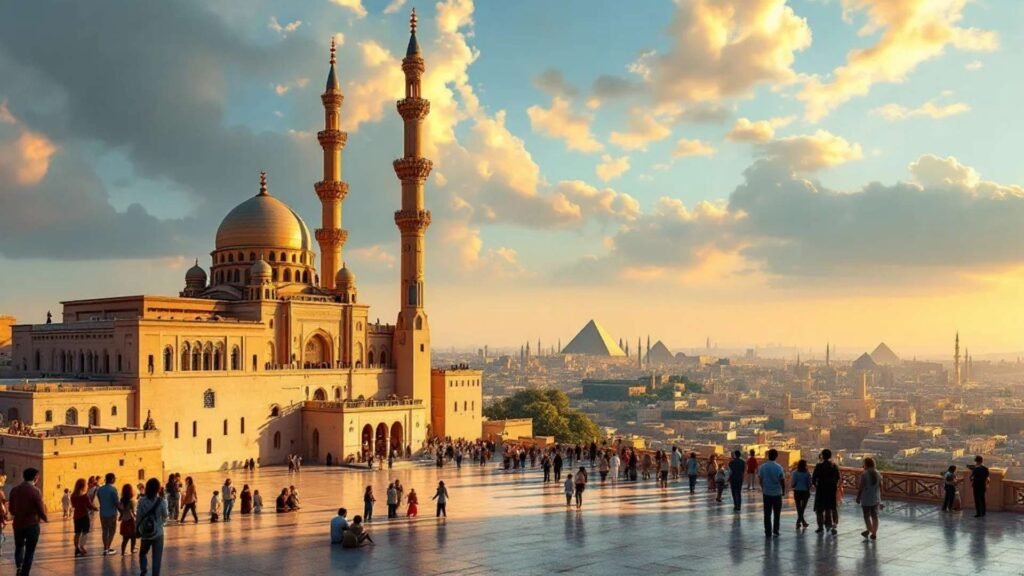
Towering above Cairo on Mokattam Hill, the Citadel of Saladin (Qala’at Salāḥ ad-Dīn) is one of Egypt’s most iconic landmarks. Built in the 12th century by the legendary Muslim leader Saladin to protect Cairo from Crusader attacks, the fortress stands today as a remarkable blend of military strength, architectural beauty, and cultural heritage. For international visitors, the Citadel is more than just a historic monument—it is a window into Cairo’s past, offering sweeping views of the city and some of the most spectacular Islamic architecture in Egypt.
1. History of the Citadel
- Founded in 1176: Saladin strategically built the fortress to secure Cairo from outside threats. Its high position made it nearly impenetrable.
- Mamluk & Ottoman Eras: Successive rulers expanded the citadel, adding mosques, palaces, and walls. It became the center of Egyptian government for almost 700 years.
- Legacy of Defense: Even today, its walls and towers reflect the genius of medieval military architecture.
2. Architectural Highlights
The Citadel is a sprawling complex with multiple gates, towers, and grand structures. Key highlights include:
- Mosque of Muhammad Ali (Alabaster Mosque): Built in the 19th century by Muhammad Ali Pasha, this Ottoman-style mosque dominates the skyline. Its massive domes and twin minarets make it one of Cairo’s most photographed monuments. Inside, chandeliers and Islamic calligraphy glow against alabaster-covered walls.
- Mosque of Sultan al-Nasir Muhammad: A Mamluk-era mosque with elegant green tiles and a peaceful courtyard, showcasing the artistic brilliance of the 14th century.
- Gawhara Palace: Built as a royal residence, it features Ottoman design and decorative halls that once hosted important ceremonies.
3. Panoramic Views of Cairo
The Citadel’s location on Mokattam Hill offers one of the best vantage points in Cairo. From its terraces, visitors can enjoy:
- Clear views of downtown Cairo, with the modern skyline stretching into the distance.
- On clear days, the Pyramids of Giza visible on the horizon.
- A bird’s-eye perspective over Islamic Cairo’s minarets, creating one of the most breathtaking cityscapes in the Middle East.
4. Museums within the Citadel
The fortress also houses fascinating museums that showcase Egypt’s military and cultural history:
- Military Museum: Displays centuries of weaponry, uniforms, and battle history.
- Police Museum: Highlights Egypt’s law enforcement heritage.
- Carriage Museum: Features royal carriages and ceremonial artifacts from the Ottoman and Muhammad Ali eras.
💡 Visiting Tips for Travelers
- Best Time to Visit: Mornings and late afternoons (especially October–April) when the weather is cooler and the sunlight creates magical views over the city.
- Tickets & Access: The Citadel requires an entrance ticket, and guided tours are highly recommended for understanding its layered history.
- What to Wear: Comfortable shoes for walking; modest clothing if visiting mosques.
- Nearby Attractions: Combine your visit with a tour of Islamic Cairo and Al-Muizz Street, just minutes away.
Conclusion
The Citadel of Saladin is more than a fortress—it is a living monument to Cairo’s resilience and grandeur. With its monumental mosques, palaces, museums, and panoramic views, the citadel stands as a must-see destination for anyone seeking to experience the soul of Cairo. Whether you come for the history, the architecture, or the stunning cityscapes, the Citadel offers an unforgettable journey into Egypt’s past and present.
Want to Explore Further? 👉 The History of Cairo: Back to the Cairo Travel Guide

